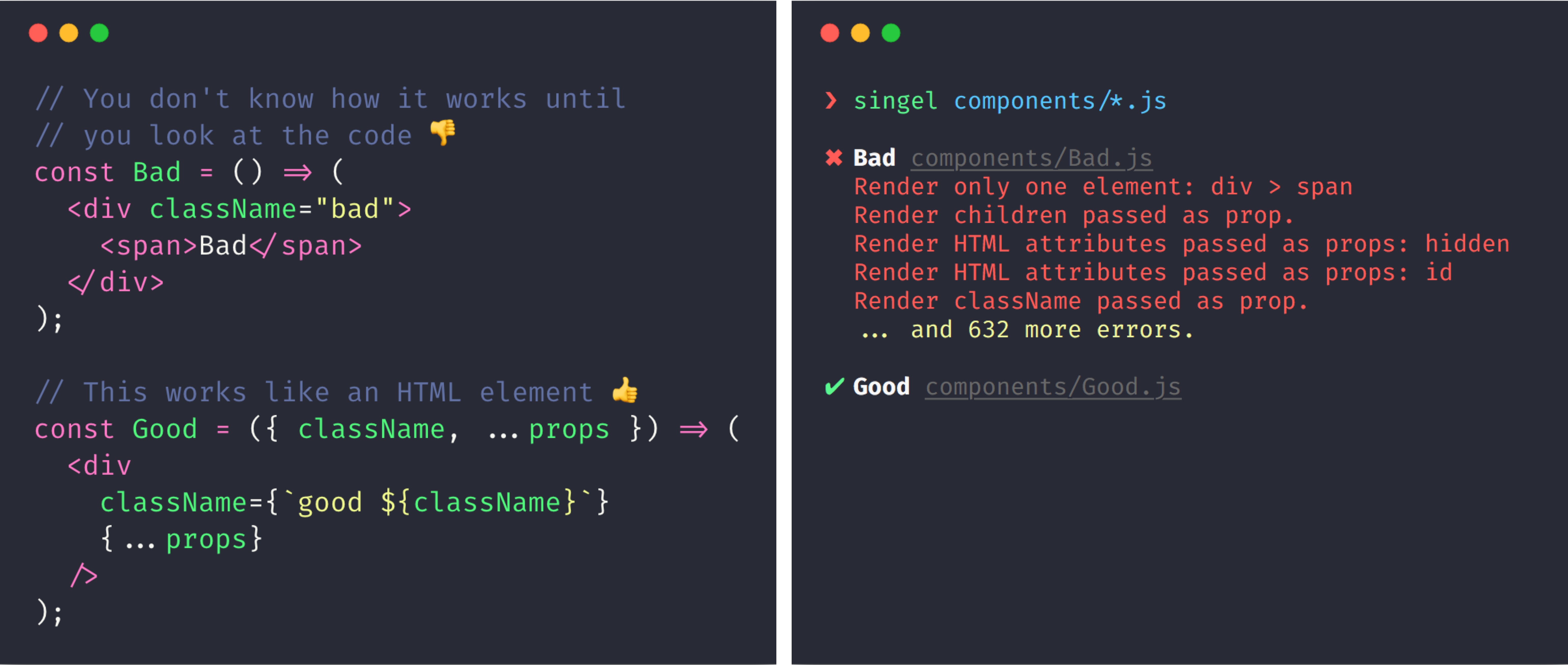https://github.com/diegohaz/singel
Single Element Pattern
https://github.com/diegohaz/singel
cli linter react react-patterns reactjs
Last synced: 8 months ago
JSON representation
Single Element Pattern
- Host: GitHub
- URL: https://github.com/diegohaz/singel
- Owner: diegohaz
- License: mit
- Created: 2018-06-01T00:45:45.000Z (over 7 years ago)
- Default Branch: master
- Last Pushed: 2022-12-08T18:54:12.000Z (almost 3 years ago)
- Last Synced: 2024-10-26T02:34:07.296Z (about 1 year ago)
- Topics: cli, linter, react, react-patterns, reactjs
- Language: JavaScript
- Homepage: https://medium.freecodecamp.org/introducing-the-single-element-pattern-dfbd2c295c5d
- Size: 703 KB
- Stars: 408
- Watchers: 11
- Forks: 20
- Open Issues: 24
-
Metadata Files:
- Readme: README.md
- Changelog: CHANGELOG.md
- License: LICENSE
Awesome Lists containing this project
- awesome-list - singel
- awesome - singel - Single Element Pattern (JavaScript)
README
# 
[](https://github.com/diegohaz/nod)
[](https://npmjs.org/package/singel)
[](https://travis-ci.org/diegohaz/singel) [](https://codecov.io/gh/diegohaz/singel/branch/master)
**Single Element Pattern** (Singel) is a set of rules/best practices to create consistent, reliable and maintainable components in React and other component-based libraries. This is based on the idea that the **building blocks** of an application should resemble as most as possible native HTML elements. [**Read full article**](https://medium.freecodecamp.org/introducing-the-single-element-pattern-dfbd2c295c5d)
This repo is a CLI tool for checking whether React components conform to the Singel pattern.

## Installation
```sh
$ npm i -g singel
```
## Usage
```sh
$ singel path/to/**/Component.js --ignore "path/to/**/ignored/Component.js"
```
## Projects applying Singel
> Feel free to send a PR adding your open source project
- [Reakit](https://github.com/diegohaz/reakit)
## Rules
### Render only one element
```jsx
// bad - 2 elements
const Element = props => (
);
// good
const Element = props => (
);
// good - if Element is good
const Element2 = props => (
);
```
### Never break the app
```jsx
// good
const Element = props => (
);
// bad - will break if getId wasn't provided
const Element = ({ getId, ...props }) => (
);
// bad - will break if foo wasn't provided
const Element = ({ foo, ...props }) => (
);
```
### Render all HTML attributes passed as props
```jsx
// good
const Element = props => (
);
// bad - not rendering id
const Element = ({ id, ...props }) => (
);
// good
const Element = ({ id, ...props }) => (
);
```
### Always merge the styles passed as props
```jsx
// good
const Element = props => (
);
// bad - not rendering className
const Element = ({ className, ...props }) => (
);
// bad - not rendering style
const Element = ({ style, ...props }) => (
);
// bad - replacing className instead of appending
const Element = props => (
);
// bad - replacing style instead of merging
const Element = props => (
);
// good
const Element = ({ className, ...props }) => (
);
// good
const Element = ({ style, ...props }) => (
);
```
### Add all the event handlers passed as props
```jsx
// good
const Element = props => (
);
// bad - not passing onClick
const Element = ({ onClick, ...props }) => (
);
// bad - replacing onClick prop
const Element = props => (
);
// good
const Element = ({ onClick, ...props }) => (
);
// good - it's ok to replace internal event handlers
const Element = props => (
);
// good - calling internal and prop
const callAll = (...fns) => (...args) =>
fns.forEach(fn => fn && fn(...args));
const Element = ({ onClick, ...props }) => (
);
```
## FAQ
### How to handle nested elements?
Say you have a `Button` element and you want to display a `Tooltip` when it's hovered. The first rule you'll want to break is rendering only one element. To handle that you have some options:
- Use CSS pseudo-elements (such as `:after` and `:before`);
- Create a non-singel element, which is fine;
- Nest styles instead of components.
Here's an example of how you can accomplish tha latter one:
```css
/* could also be CSS-in-JS */
.button {
position: relative;
/* more button css */
}
.button:hover .tooltip {
display: block;
}
.button .tooltip {
display: none;
position: absolute;
/* more tooltip css */
}
```
```jsx
const Button = ({ className, ...props }) => (
);
Button.Tooltip = ({ className, ...props }) => (
);
```
Usage:
```jsx
😁
Hover me
```
Both `Button` and `Button.Tooltip` are single elements. You have all the benefits you would have by nesting them, but now with complete control over `Button.Tooltip` from outside.
## License
MIT © [Diego Haz](https://github.com/diegohaz)